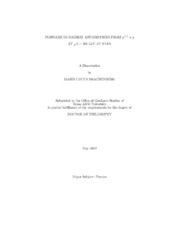| dc.description.abstract | One unresolved question in hadronic physics is the origin of large transverse single-spin asymmetries, AN, observed in hadron production from high-energy polarized-proton collisions. Collinear perturbative Quantum Chromodynamics (pQCD) predicts that AN should scale with the quark mass, however, experiments have since reported large AN for inclusive hadron production. Recent measurements from RHIC
experiments show examples of these asymmetries at forward angles in a kinematic region where pQCD cross-section calculations reasonably agree with measured cross-sections.
Disentangling dynamical contributions to AN from hadro-production requires moving beyond inclusive measurements. One possibility is to investigate asymmetries in two-particle correlations due to Interference Fragmentation Functions (IFF) and the Sivers effect. In 2008, RHIC dedicated a portion of the run to transversely polarized proton collisions at sqrt(s) = 200 GeV. STAR was equipped with a Foward Meson Spectrometer (FMS) and a Forward Time Projection Chamber (FTPC), overlapping in the pseudorapidity range of 2.5 < eta < 4. By analyzing neutral pions with the FMS correlated with charged particles from the FTPC, correlation asymmetries can be measured at kinematics where large inclusive asymmetries have been measured.
Correlations are measured for pi^0's with 2 < pT, pi^0 < 5 GeV/c and associated charged particles in two ranges of transverse momentum: 1 < pT, ch < 2 GeV/c and 0.5 < pT, ch < 1 GeV/c. IFF and Sivers asymmetries manifest themselves through the correlation of two particles from the same jet. These events are selected through a cut on the pair radius, delta R. Gain non-uniformities and electronics failures have resulted
in large holes in trigger acceptance and associated particle acceptance, respectively. This non-uniform acceptance allows the Sivers and IFF effects to mix and distort the raw asymmetries. Techniques are developed to measure this leak-through by means of unpolarized yields and event weighting. They result in small corrections to the asymmetries.
IFF and Sivers asymmetries both for xF > 0 and for xF < 0 are reported for forward-angle pi^0-charged particle correlations from polarized-proton collisions at sqrt(s) = 200 GeV. Asymmetries are shown corrected for full underlying-event and pileup backgrounds, as well as corrected only for pile-up contributions. It appears the asymmetries are less sensitive to delta R when corrected for the full underlying-event background. Unfortunately, statistics limitations preclude a firm conclusion. | en |


